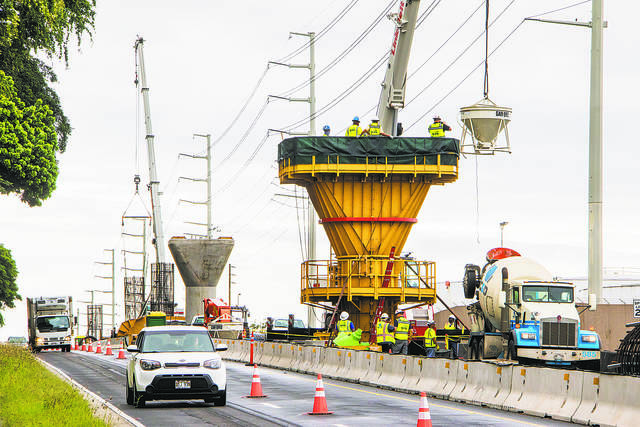“On budget and on time.”
Weary taxpayers have long since given up that ghost, years after that catchphrase was repeatedly used by city officials regarding Oahu’s rail project. The project, after all, is now overbudget by at least $3 billion and several years behind schedule.
All the more reason, then, for contracts and work going forward to be as transparent and cost-justified as possible. And that’s why the Honolulu Authority for Rapid Transportation (HART) will be strictly scrutinized in administering its latest contract award: up to $400 million to local construction firm Nan Inc. to relocate utilities in the 4.1-mile “City Center” stretch, from Middle Street to Ala Moana Center.
The contract specifies the ceiling amount — $400 million — but by virtue of this being an “Indefinite Delivery/Indefinite Quantity (IDIQ)” contract, it is signaling the job’s many unknowns. That’s worrisome, even if this urban corridor has long stirred trepidation.
As recently as mid-October 2017, HART CEO Andrew Robbins and project director Sam Carnaggio valued the utility-relocation contract at about $200 million. Now, a half-year later, best-guess variables have potentially doubled the estimated value of this contract.
The state Legislature imposed tighter money-managing oversight when it OK’d rail’s second financial bailout in a September special session. Conditions included a far-reaching state audit, plus signoffs on reimbursements sought by HART from the general excise tax surcharge.
For taxpayers, the new “up to $400 million” contract for utility relocation would benefit from the enhanced scrutiny.
Cost of eruption could go way up
What a dramatic week it’s been for our Hawaii island ohanas — far too dramatic, unfortunately.
The power of nature — or Pele, the volcano goodess, to some — is in full force as over two dozen homes have already been destroyed in the Leilani Estates subdivision; up to 1,800 evacuated from there and nearby Lanipuna Gardens; and the threat grows from a Kilauea summit eruption.
One bit of peace of mind came very early Thursday when 60,000 gallons of the flammable chemical pentane was removed from the Puna Geothermal Venture site, perilously close to where fissures had emerged. The geothermal plant had been shut down, but worries persist about potential hazards from hydrogen sulfide or sulfur dioxide if any of PGV’s deep wells are compromised.
The highly unpredictable path of lava outbreaks, combined with increased seismic activity, has the entire Puna District on edge — and rightly so.
Thankfully, President Donald Trump on Friday signed a declaration proclaiming the state a “major disaster” in the wake of Hawaii island’s volcano activity. Protecting island residents over the next 30 days is expected to exceed $2.9 million, not including permanent road repairs or earthquake damage.
But most ominously, there’s this: Costs will “skyrocket” should air and/or sea evacuations become necessary.
“As more fissures open and toxic gas exposure increases, the potential of a larger scale evacuation increases,” said Gov. David Ige. “A mass evacuation of the lower Puna District would be beyond current county and state capabilities.”
That’s scary even to contemplate. Even as volcanic gases build, so does the dreadful suspense of what’s next.
New school rising in Kapolei
It’s always welcome news when a new school breaks ground. And when it’s located in fast-growing Kapolei, so much the better.
This week, earth was turned to begin work on East Kapolei Middle School, a 1,050-student school for grades 6, 7 and 8. Science, technology, engineering and math (STEM) education will be a major focus of the curriculum.
The $59 million first phase is scheduled to be completed in time for the 2020-21 school year. This year, the Legislature approved $13 million for construction of the second phase, which will include health and physical education facilities. And looking ahead, the Legislature also approved $1 million to design a new East Kapolei elementary school.
The new middle school will boast the latest in cool, energy-efficient design — an important consideration, given that complaints about overheated classrooms in the hot, dry area prompted the spending of millions of dollars to air-condition or otherwise bring down the temperature in school buildings.
One longstanding issue remains: Where will all these kids will go after Grade 8? Space already is in short supply.
Earlier this year, James Campbell High School, packed to the rafters with more than 3,000 students, started construction on a much-needed 27-classroom building. And proposals have been made for another high school in the area. Stay tuned.

